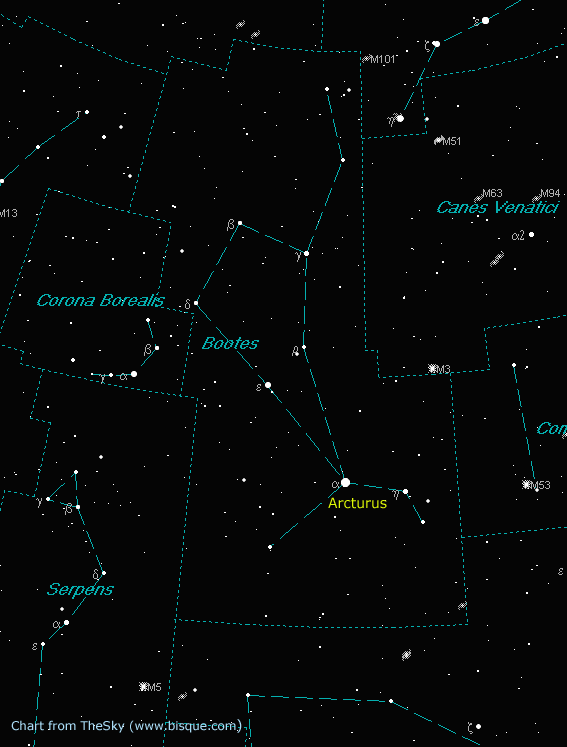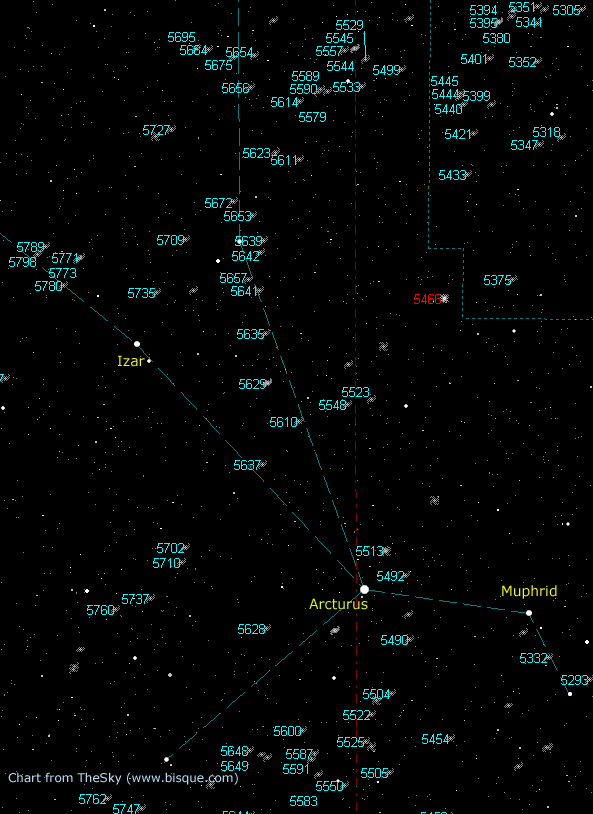Bootes - The Herdsman
At this time of year, the first star to appear in the darkening dusk skies is Arcturus. With a magnitude value of -0.11 Arcturus is listed as the fourth brightest star in the entire sky behind Sirius, Canopus and Rigel Kentaurus. It is also designated as the Alpha star in the constellation Bootes the Herdsman. A technique to locate this K2 sun is to find the handle of the Big Dipper and simply follow the arc to Arcturus. At the beginning of the month, it crosses the meridian at 10:30 local time. Arcturus lies only 35 light-years from Earth and has a proper motion. It is strolling through space at a leisurely 118 km/sec.
From Arcturus move your scope a full five degrees westward to the star called Muphrid. Although Muphrid has a spectral class of G0 (our Sun is G2) it has currently evolved into subgiant class. It is now nine times brighter than our Sun. Muphrid has a very close companion star that astronomers think is a dead white dwarf. This little star takes 1.4 years to orbit Muphrid – its parent or simply put, about the distance between the Sun and Mars.
The first telescopic object on our list is NGC 5248 or Caldwell 45. It is a compact SaB spiral galaxy some 59 million light-years from us. To locate this galaxy using Arcturus as a starting point, drop down ten degrees south and a degree and a half to the west till your rods in your eyes (used to detect faint light) pick up the magnitude 10.9 smudge.

For a challenge, try locating NGC 5466. This magnitude 10.5 dim patch is a distant globular cluster. At a distance of 52 thousand light-years, this cluster could be a challenge visually. From Arcturus, slew your scope nine degrees to the north and a bit to the west.
I find edge-on galaxies to be beautiful and mysterious, in the sense you cannot really decipher the true shape and mottling of the galactic arms. It is like looking at a dinner plate from its side. To see an example of this, go six degrees north from Arcturus till you come upon NGC 5523. This island of billions of suns measures 4.5 arc minutes long by 1.0 arc minute wide and has an estimated distance of 79 million light-years from Earth. A very pretty pairing of a couple of galaxies are NGC 5587 and NGC 5591 to which they have a slight separation of only half the width of the full moon. They are found almost six degrees south-east of Arcturus.
Venus can now be found in the low western sky along with tiny Mercury. As May came to a close, the planet Jupiter was one point in the triangle of planets that noticeably changed orientation from night to night. But Jupiter has now entering into the glare of the Sun and will not be visible for a few weeks when it will own the morning sky. Keep following Venus the two planets as Venus overtakes Mercury on the 21st. Saturn is well up in the east at sunset and owns the night. Its majestic rings can be glimpsed in any telescope.
Summer is the season for public star parties across Canada. These nights allow the general public to view amazing celestial objects through a variety of telescopes as well as learning about the night sky. Here is a great opportunity to road test a wide variety of scopes. This month’s new moon occurs on the 8th at 11:57 EDT. The Full Strawberry/Honey moon is on the 23rd at 7:32 EDT. The Summer Solstice officially rings in at four minutes past midnight EDT on the 21 but late night on the 20th as you move westward across North America. Solstice means ‘sun stands still’ and marks the highest point the Sun reaches on the northern portion of the ecliptic.
Until next month, clear skies everyone.

